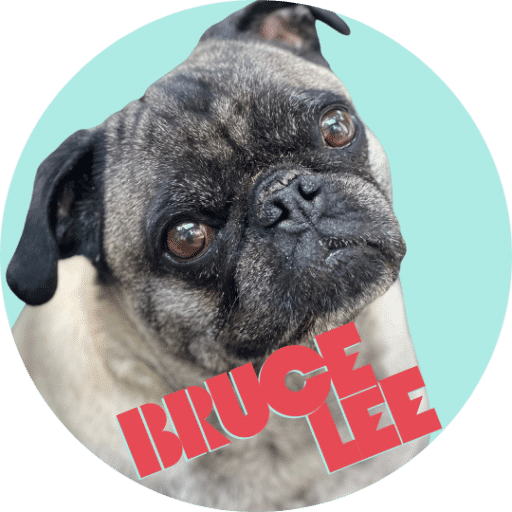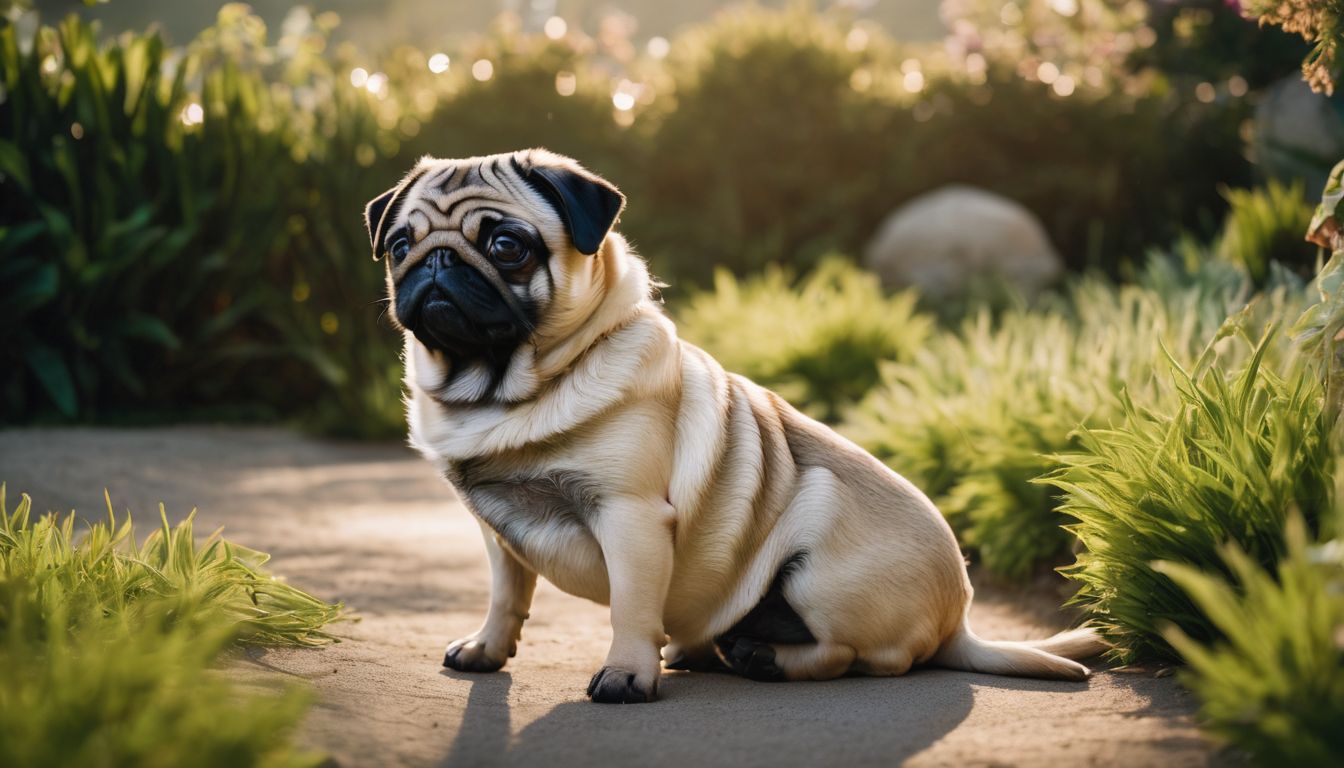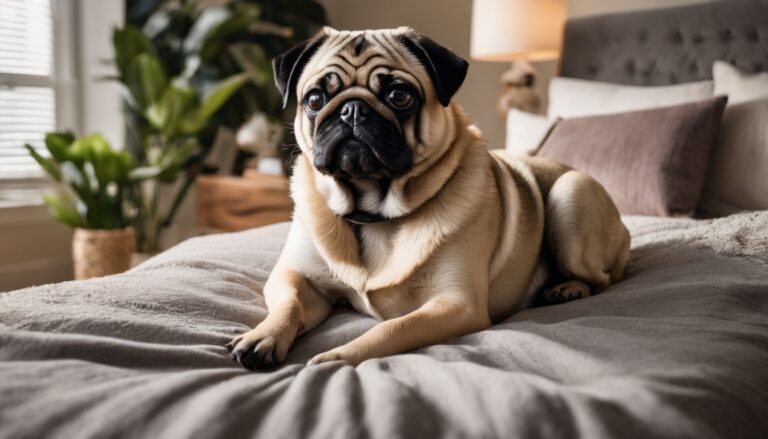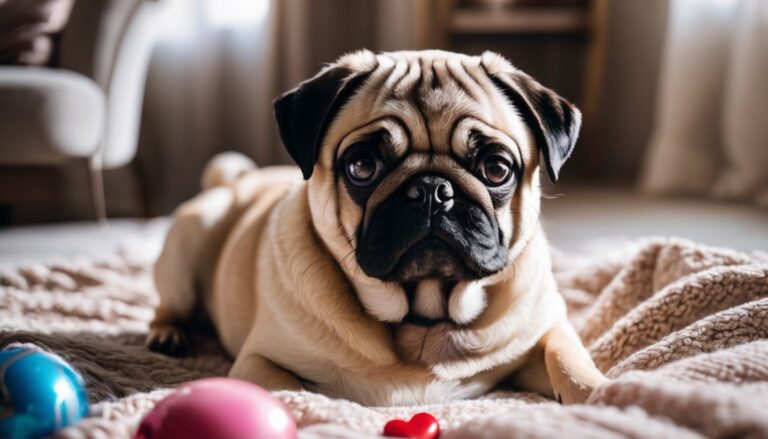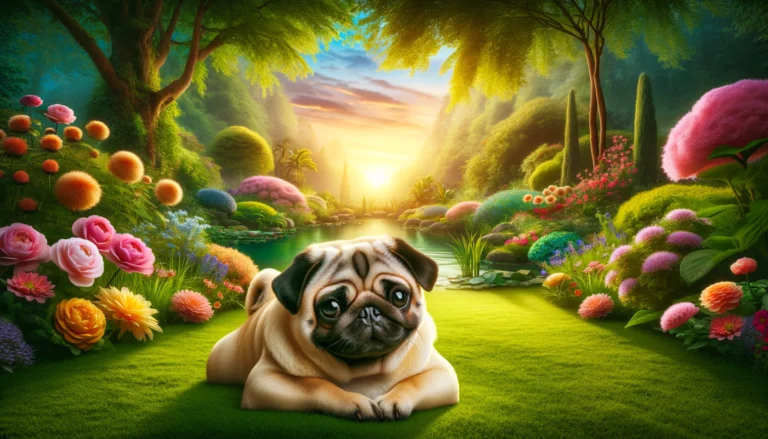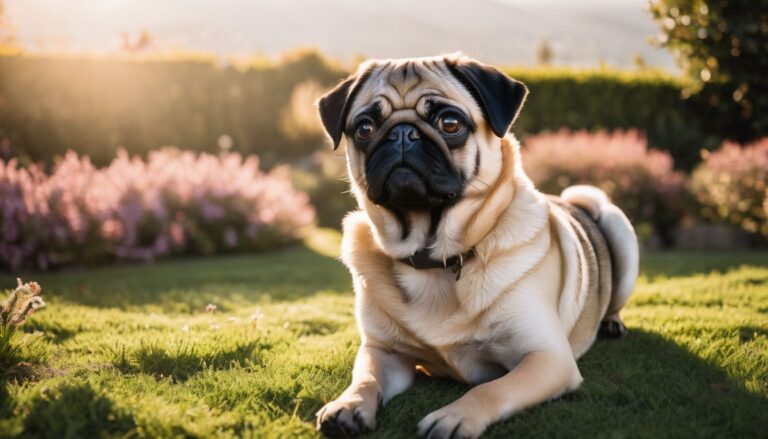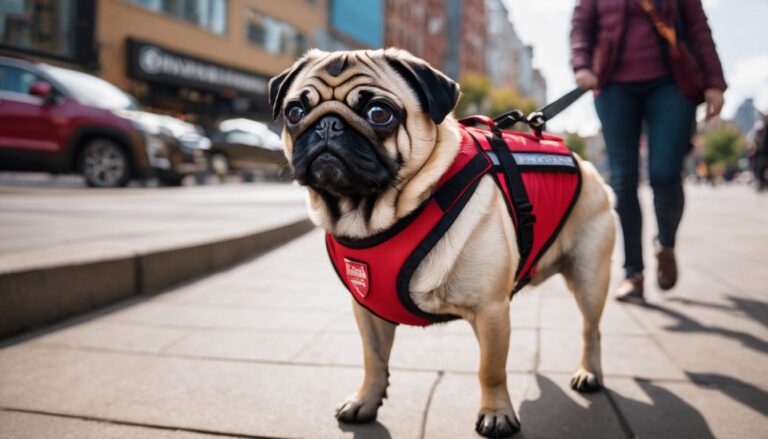Do Pugs Have Tails? Exploring The Tail Traits Of Pugs
Do Pugs Have Tails?
Ever caught yourself wondering about the whimsical curl in every pug’s tail you’ve come across? Well, you’re certainly not alone. We found ourselves captivated by this charming enigma and took it upon ourselves to dig a little deeper.
Turns out, this trademark spiral is more than just a fashion statement—it’s rooted in genetics and steeped in breed history. Join us as we twist our way through the backstory of the pug’s playful appendage; it’s an endearing narrative filled with surprises that we’re excited to share with fellow dog lovers!
Key Takeaways
- Pugs’ curly tails are a result of selective breeding practices dating back to ancient China, where they were considered emblems of nobility and possibly symbols of good luck.
- Only about 25% of pugs have the highly sought – after double curl in their tails, which is a sign of good breeding according to breed enthusiasts and standards like those from the American Kennel Club.
- The unique spiral shape comes from a genetic mutation affecting the structure of interlocking vertebrae in the spine and tail. This has been preserved through intentional mating selections over time.
- A limp or uncurled tail can indicate health issues in pugs; regular grooming and careful handling are essential for maintaining this distinctive feature’s health and preventing potential problems.
- Aside from pugs, several other dog breeds such as Basenjis, Akitas, Chow Chows, Samoyeds, Shiba Inus, Alaskan Malamutes, and American Eskimo Dogs also share the characteristic of having curly tails.
The History of Pugs and Their Curly Tails
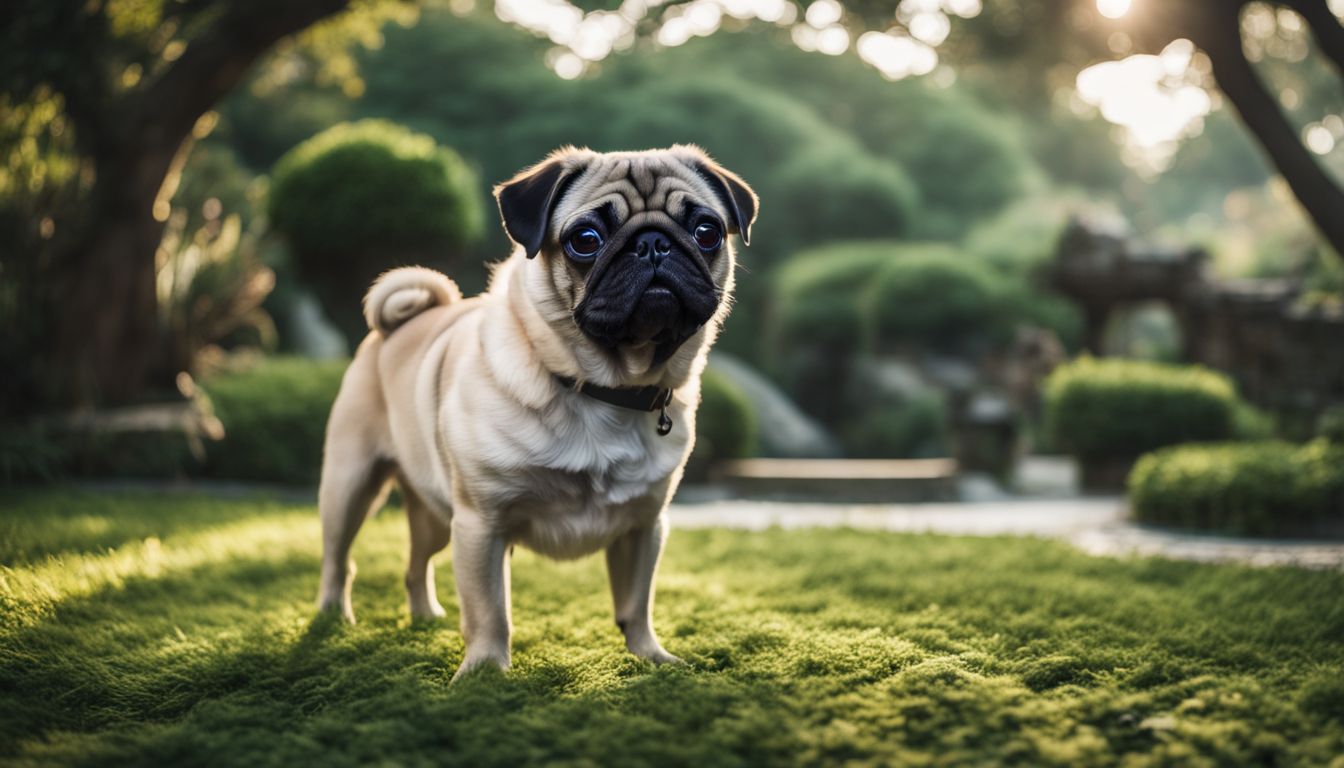
Pugs have a long history dating back to ancient China, where their distinctive curly tails were highly prized. The tail’s unique shape is thought to be the result of selective breeding practices and may have even been considered a good luck charm by some cultures.
Additionally, genetic mutations could also play a role in shaping the iconic Pug tail.
Selective breeding practices
Selective breeding practices have shaped the iconic curly tail of pugs, turning it into a breed standard that enthusiasts and the American Kennel Club admire. Breeders carefully choose which dogs to mate based on their tail’s curliness, aiming for that tightly curled or even prized double curl appearance.
This meticulous selection not only emphasizes aesthetics but also ensures the trait is prominent in future generations.
Knowing this, we understand why only a quarter of registered pugs flaunt the coveted double curled tail. As dog lovers who cherish these unique traits, we prioritize good breeding practices to preserve this signature look while maintaining health standards.
With each mating choice, breeders are crafting not just a show-worthy appearance but also safeguarding the legacy of pugs as they continue to win hearts as one of the most beloved lapdogs.
Breeding history
Pug dogs have a fascinating breeding history that takes us back to ancient China. They were cherished by emperors and often lived in luxurious accommodations, receiving the best care possible.
Breeders at that time shaped many of their distinctive features, including their famous curly tails. As these dogs made their way to Europe, they continued to be symbols of high status.
European breeders admired the curly tail trait and selectively bred Pugs to ensure this feature was prominent.
Our beloved Pugs finally made an official mark on dog shows when the American Kennel Club recognized them in 1885. The breed standards established by the AKC included the pug’s curled tail as an essential characteristic.
Prestigious curls became synonymous with healthy and well-bred pugs, leading today’s owners to prize this unique spiraling trademark highly. This commitment from past breeders has left us with the adorable curling tails we see wagging on our Pug friends today.
Potential good luck charms
Many of us cherish the sight of a pug’s curly tail, and for good reasons. It’s not just adorable; this unique trait is steeped in history and symbolism. In ancient China, where pugs originated, their coiled tails were admired by nobility and associated with prosperity.
They were often found warming the laps of emperors and became tokens of luck within royal circles. Today, we carry on that tradition by regarding these little spirals as harbingers of good fortune for our homes.
The double curl is especially prized among us pug enthusiasts – it’s like having a charm made purely from our furry friend’s genetics! Only about 25% of registered pugs boast this rare feature, which increases their value in the breeding world and supports their status as living symbols of luck.
We love to watch those tail curls bounce as our pugs trot around happily – each wag seems to whisper tales of good breeding and centuries-old beliefs in serendipity.
Genetic mutation
The curled tail of pugs is a distinctive feature resulting from a genetic mutation. This unique trait has been selectively bred for and is considered a sign of good breeding. The shape of the spine and tail, composed of small interlocking vertebrae, is responsible for the pug’s trademark curly tail.
In conclusion, understanding the genetic mutation behind the pug’s curly tail sheds light on the deliberate breeding practices that have shaped this breed’s iconic appearance.
Genetics & the Curly Tail
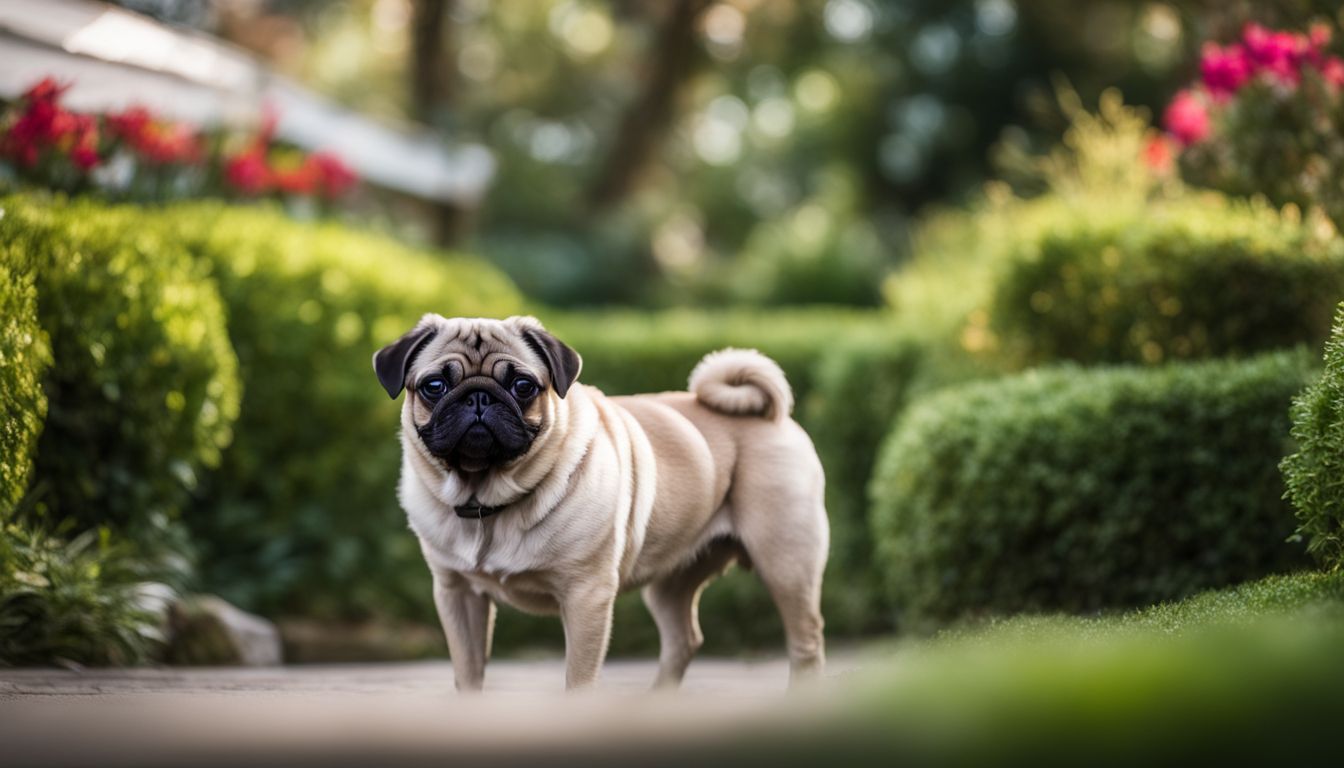
The shape of the spine and tail, made of small, interlocking vertebrae, is responsible for the Pug’s trademark curly tail. Only 25% of registered pugs have the valuable double curl in their tails.
The curled tail is a result of selective breeding for a genetic mutation and is a sign of good breeding.
The Unique Tails of Pugs
Pugs are known for their unique curly tails, which can come in different shapes and sizes. It’s important to understand what a normal pug tail looks like, how it may uncurl, and what a limp tail could indicate about your pug’s health.
Understanding these traits will help you better care for your pug’s tail and overall well-being.
Different types of tail shapes
Pugs exhibit different tail shapes, including single and double curls. A single curl is a semi-circle, whereas a double curl forms two spirals at the base and tip of the tail. Some pugs may have loose or uncurled tails, which can be straight or slightly curved.
Additionally, some pugs have tightly coiled tails that resemble a corkscrew pattern. Occasionally, pugs may display variations such as kinked or wavy tails, which contribute to their unique and endearing appearance.
Normalcy of a Pug’s tail uncurling
Pug puppies are typically born with straight tails that gradually develop their characteristic curl as they grow. The tail should be fully curled by 3 or 4 months, although in some cases it may take up to 6 months for the tail to uncurl completely.
It is crucial for pug owners to understand this process and give the puppy time to naturally develop its signature curly tail.
Understanding the normalcy of a Pug’s tail uncurling allows for proper care and observation during this developmental period. Owners should pay attention to any unusual changes in the tail shape or behavior and consult a veterinarian if there are concerns about the development of the Pug’s tail.
What a limp tail may indicate
A limp tail in a Pug could point towards potential illness or injury, warranting prompt assessment by a veterinarian. It’s crucial to note that elderly Pugs may exhibit looser tails, and if accompanied by reduced appetite, this droopy tail might signal an injury termed as “limp tail,” often related to the tailbone.
Recognizing these signs and seeking professional guidance is essential for the well-being of our beloved furry companions.
Funny angles and their meaning
When observing a pug’s tail, it’s essential to pay attention to any unusual angles or positions. A raised tail can indicate excitement or confidence, while a tucked tail could signal fear or anxiety.
If the tail is consistently held at an odd angle, it may be a sign of discomfort or injury. Pug owners should monitor their pet’s tail position for changes and seek veterinary advice if they notice persistent irregularities.
Understanding these funny angles can help ensure your pug’s well-being and happiness.
Are Brindle Pugs Rare? – Exploring Tail Color Variations
Brindle Pugs are not particularly rare, as the brindle coat pattern is a common variation among Pugs. The distinct coloring of brindle pugs comes from a mix of fawn and black hairs in a striped or swirling pattern, creating a unique and eye-catching appearance.
Brindle coats adhere to breed standards, and many reputable breeders intentionally select for this attractive coloration to preserve the diversity within the Pug community.
The American Kennel Club (AKC) recognizes brindle as one of the standard colors for Pugs, underscoring its prevalence within the breed. It’s important to note that while some may regard certain coat types or patterns as rare due to personal preferences or regional differences, brindle Pugs are widely recognized and cherished by enthusiasts worldwide.
Are White Pugs Rare? – Discussing Tail and Coat Correlation
White Pugs are not as common as their fawn counterparts, making them relatively rare within the breed. The coloration of a Pug’s coat is linked to its genetic makeup, and the correlation between color and tail type has been an area of interest for Pug enthusiasts.
While white Pugs possess the same distinctive curly tail as other colored Pugs, they stand out due to their unique coat shade, adding to their allure among dog lovers. This makes them sought after among those looking for a distinct and exceptional canine companion.
Caring for a Pug’s Curly Tail
When caring for a Pug’s curly tail, proper grooming is essential to prevent any discomfort or health issues. Avoiding injury and paying attention to the unique angles and movements of their tails can also help maintain their overall well-being.
Proper grooming
Regular grooming is crucial to keep a Pug’s curly tail clean and free from dirt. It’s essential to brush and clean the tail area regularly to prevent skin infections or irritations.
Trimming the hair around the tail can help maintain proper hygiene, preventing matting or tangling of the fur in that area. Always check for redness, swelling, or unusual discharge on the tail, seeking veterinary care when necessary.
Be mindful of the tail when bathing your Pug, ensuring thorough drying afterward to prevent any skin issues.
Avoiding injury
To ensure the well-being of our curly-tailed companions, preventing injury is crucial. We need to be mindful when handling and grooming our pugs’ tails, as they are susceptible to “screw tail” or “hemivertebrae,” which can cause discomfort and pain.
Regular inspection and cleaning of the tail area are essential for preventing infections or irritations. Using a harness instead of a collar during walks can help prevent strain or injury to the neck and tail.
When selecting bedding or furniture, it’s important to consider the pug’s tail to avoid any accidental injuries or discomfort.
Behavioral considerations
Pugs with curly tails may experience discomfort or pain, affecting their behavior and mood. Their ability to communicate through tail wagging is limited, potentially leading to misunderstandings in social interactions.
Understanding the behavioral implications of a Pug’s curly tail is crucial for providing appropriate care and addressing potential challenges related to this unique trait. Special attention should be given to ensure their comfort and well-being, especially in grooming and handling of the tail.
The genetic mutation responsible for the curly tail in Pugs might also be linked to other behavioral traits, which could impact their overall temperament and behavior. This makes it important for Pug owners to have insights into how their pet’s unique physical traits could influence behaviors, ensuring they adapt care accordingly.
Other Dog Breeds with Curly Tails
Pugs, while uniquely known for their curly tails, are not the only dog breed with this distinct feature. Here are other breeds that also boast curly tails:
- Basenji – This ancient African breed is known for its tightly curled tail that sits over the back.
- Akita – A large Japanese breed with a curly tail that curls over the back or to either side.
- Chow Chow – This Chinese breed has a thick and furry tail that curls over the back.
- Samoyed – Known for its “S” shaped tail that curls up and over its back, adding to its fluffy appearance.
- Shiba Inu – A spitz-type breed from Japan, the Shiba Inu has a thick, curled tail which sits high on its back.
- Alaskan Malamute – This powerful Arctic breed’s tail is properly furred and carried over the back in a graceful sickle curve.
- American Eskimo Dog – Its characteristic plume of a tail curves up and over the back in an elegant flourish.
Questions About Pugs
What is the temperament of pugs with children? What are the common health concerns for pugs? How much grooming do they require? Can pugs serve as emotional support dogs? Do they have a high trainability level compared to other breeds and what is their lifespan expectancy? Are they cost-effective in terms of purchasing puppies, and how does their intelligence compare to that of other breeds?
Temperament with children
Pugs are known for their gentle and affectionate temperament, making them great companions for children. Their playful and loyal nature makes them an ideal family pet, as they are patient and tolerant with young kids.
Renowned for being cheerful, friendly, and social, Pugs enjoy spending time with children, adding a joyful dynamic to family life.
Pug’s reputation as charming and loving pets towards children has made them a popular choice among families seeking a companion that can seamlessly integrate into their household.
Health concerns
Pugs, unfortunately, suffer from various health issues due to generations of selective breeding. Their distinctive appearance has led to respiratory problems caused by their shortened snouts, which can significantly impact their quality of life.
Additionally, pugs are prone to a range of medical conditions that may require special attention and care. It’s essential for Pug owners to be mindful of these potential health challenges so they can provide the best possible care for their beloved pets.
Veterinarians stress the importance of monitoring any changes in a Pug’s behavior or physical condition closely. A limp tail could indicate illness or injury and should be promptly evaluated by a veterinarian to ensure the well-being of the dog.
Grooming requirements
To keep our pug’s curly tail healthy and looking its best, regular grooming is essential. Gentle brushing at least once a week will help to remove any loose hair and prevent matting around the tail area.
It's important to check for any signs of irritation or infection, keeping the skin clean and dry. Additionally, it's crucial to inspect the tail for any injuries or abnormalities that may require attention from a veterinarian.
Regular baths are also essential for maintaining overall cleanliness, but be sure to use a mild shampoo specifically formulated for dogs to avoid irritating their sensitive skin. After bathing, it’s important to thoroughly dry the tail area to prevent moisture-related issues such as fungal infections.
Emotional support dogs
Pugs make excellent emotional support dogs because of their loving and devoted nature. Their innate ability to sense and respond to their owner’s emotions provides comfort and companionship, making them ideal for providing emotional support.
Many individuals find solace in the presence of a Pug, finding that their loyal and affectionate demeanor aids in easing feelings of anxiety or stress.
Their comforting presence can be particularly beneficial for those seeking emotional support, as Pugs are known for their intuitive understanding of human emotions. For many people, the companionship and empathy offered by a Pug can significantly impact their overall well-being, making these dogs popular choices as emotional support animals.
Trainability
Pugs are intelligent and eager to please, making them relatively easy to train. They respond well to positive reinforcement and consistent routines, which can help reinforce good behavior.
It’s important for pug owners to start training early, as these dogs may have a stubborn streak if not properly guided. By using rewards-based methods and maintaining patience, pugs can excel in obedience training and even perform tricks with the right motivation.
Consistency in training is key when working with pugs, as they thrive on routine and clear expectations. It’s also vital to keep training sessions short but frequent, allowing for digestible learning experiences while preventing boredom or frustration for both the pug and the owner.
Cost of puppies
Pug puppies can vary in cost based on factors such as breeder reputation, lineage, and geographic location. The expenses may also fluctuate due to specific tail traits that are more rare or desirable.
Puppies with a unique double curl in their tails might be priced higher since they are considered rarer according to the breed standard and selective breeding practices.
The rarity of certain tail traits, such as the distinctive double curl or color variations, can contribute to the price variation among Pug puppies. It’s important for potential owners to consider these factors when budgeting for bringing a new furry family member into their home.
Intelligence compared to other breeds
Pugs are often underestimated when it comes to intelligence, but they surprise many with their cleverness. Their ability to understand and respond to emotions sets them apart from other breeds.
Pugs also have a strong sense of intuition that makes them excellent emotional support dogs, offering comfort and companionship in times of need. While they may not excel in obedience training like some other breeds, their unique personalities make up for it, endearing them to many as affectionate and loyal companions.
Their intelligence shines through in various ways, including their problem-solving skills and adaptability. Pugs may not be at the top of the class in obedience training, but they have an innate charm and wit that wins over the hearts of those around them.
Lifespan
Pugs usually have a lifespan ranging between 12 to 15 years. However, due to their distinct facial structure and brachycephalic nature, they are prone to various health issues which can affect their longevity.
These health concerns include respiratory problems, eye issues like corneal ulcers, dental problems, and skin fold dermatitis. Regular veterinary check-ups along with proper care and attention help in ensuring a longer and healthier life for these adorable companions.
Their average lifespan is affected by factors such as genetics, environment, diet, exercise habits, and overall healthcare provided by the owner. To ensure that your pug lives a full life, it’s crucial to be aware of potential health risks associated with the breed and take proactive measures to mitigate them accordingly.
Do Pugs Have Tails Conclusion
In conclusion, the curly tail of a pug is a distinctive feature that reflects the breed’s noble history and selective breeding practices. Understanding the genetic basis and care requirements for this unique trait can help pug owners provide optimal support for their furry companions.
With proper grooming and awareness of potential health concerns, pug enthusiasts can ensure that these charming dogs live happy and healthy lives. Exploring the fascinating traits of pugs’ tails unveils not only their physical characteristics but also enriches our appreciation for this beloved canine companion.
Do Pugs Have Tails FAQs
1. Why do pugs have curly tails?
Pugs are born with curly tails due to their genes. This unique trait is part of the breed standard set by dog clubs like the Fédération Cynologique Internationale (FCI) and the Australian National Kennel Council (ANKC).
2. Can a pug’s tail uncurl?
Sometimes, a pug’s tail might temporarily straighten when relaxed or asleep. However, it will usually return to its curly shape.
3. Do all pugs have the same kind of curl in their tails?
No, each pug has a slightly different tail curl, but most pugs should have at least one spiral loop in their tails according to breed standards.
4. Is there any special care needed for a pug’s curly tail?
Yes, you should keep your pug’s tail clean because its curls can trap dirt. Check regularly around the coils and gently clean as needed to keep your pup happy and healthy!
